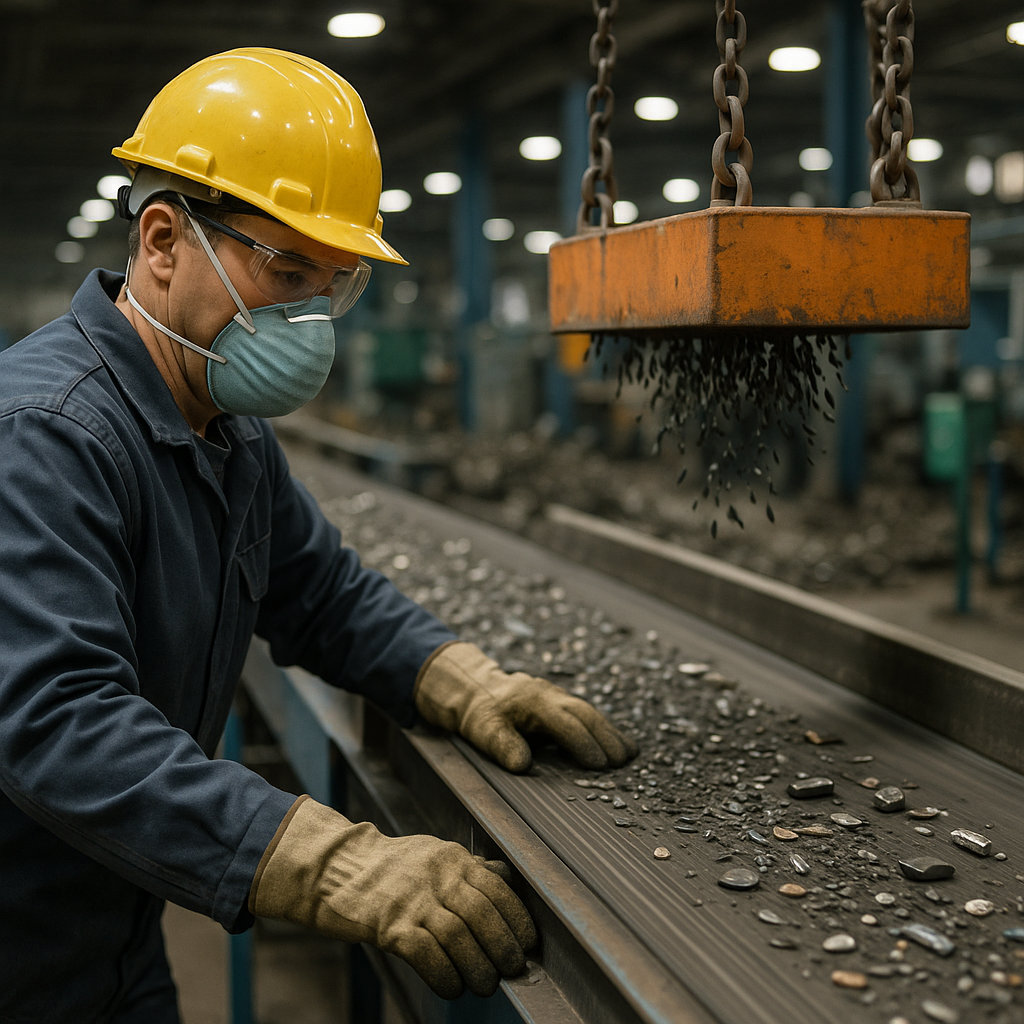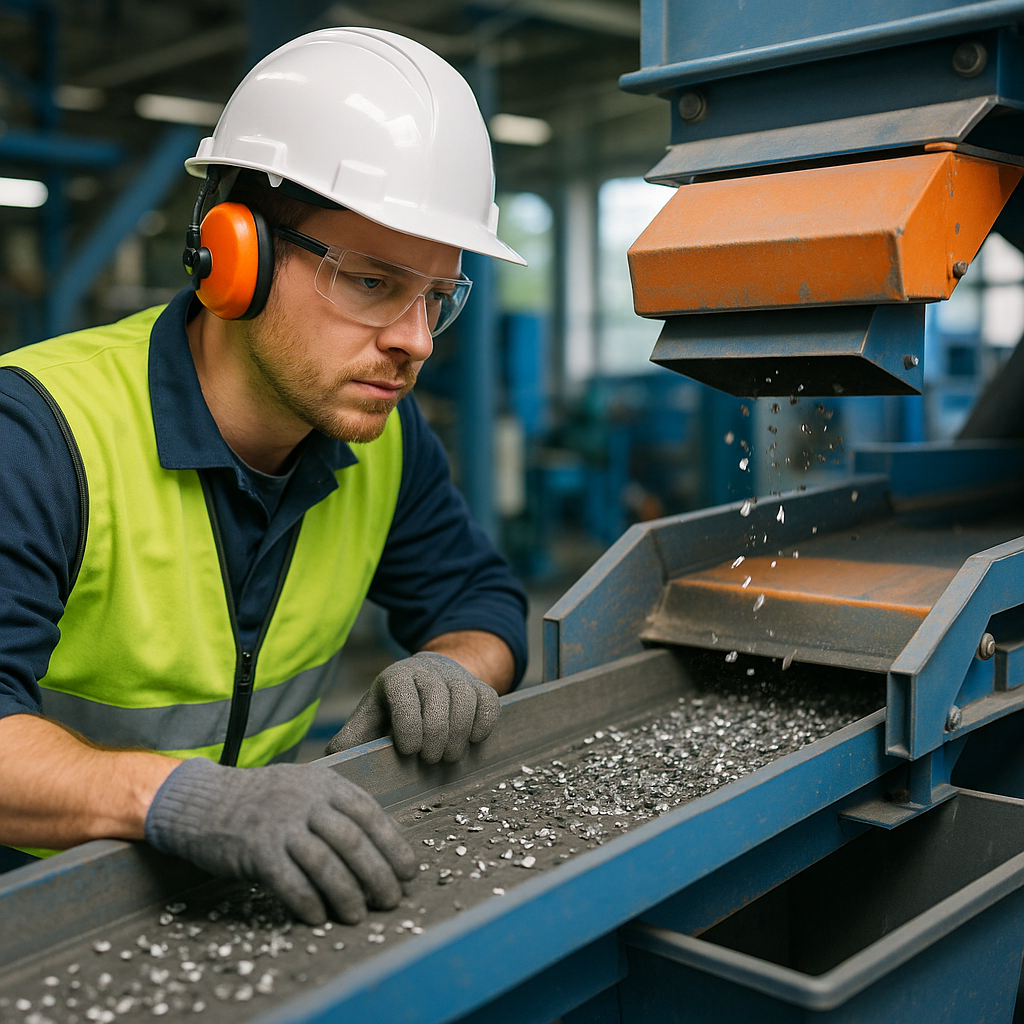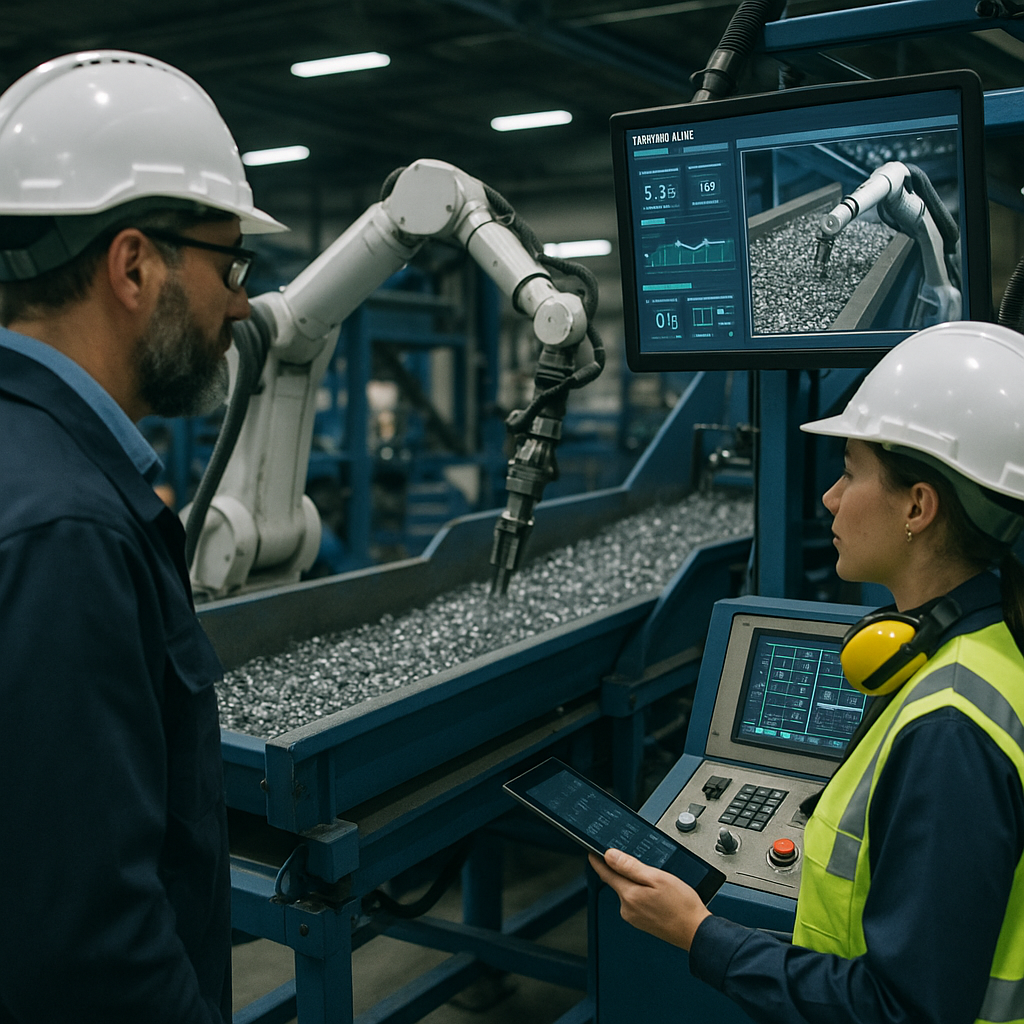5901 Botham Jean Blvd, Dallas, TX 75215
Separating Ferrous and Non-Ferrous Fines in Metal Recycling: Methods, Challenges
October 14, 2025In metal recycling, materials are categorized into two types: ferrous and non-ferrous. This classification is fundamental to the recycling process and directly affects value recovery. Ferrous fines contain iron and have magnetic properties. These are small particles of steel, iron, and other iron-containing alloys that can be captured using magnetic separation techniques.
Non-ferrous fines, in contrast, lack iron content and do not respond to magnets. These valuable materials include aluminum, copper, brass, lead, and zinc fragments. The smaller size of these particles—hence the term “fines”—requires specialized sorting methods beyond simple magnetic separation.
Distinguishing between these materials is crucial in recycling operations. Proper identification and separation enhance processing efficiency and economic value. A load of mixed metal scrap containing both types will typically be valued at the lower ferrous rate, even if valuable non-ferrous metals make up a substantial portion. This pricing reality makes accurate sorting essential for maximizing the return on recycled materials.
How does magnetic separation work for ferrous and non-ferrous fines?

Magnetic separation is an effective process for sorting ferrous metals from non-ferrous materials in recycling and waste management facilities. It leverages the magnetic properties of materials to achieve efficient separation with minimal energy consumption.
Fundamentally, magnetic separation exploits the magnetic properties of ferrous metals, which contain iron and respond readily to magnetic fields. When waste materials move through a magnetic field, ferrous components are attracted, while non-ferrous materials continue uninterrupted.
The process starts when mixed waste materials enter the separation system via conveyor belts or vibrating feeders. As this stream passes through magnetic separation equipment, powerful magnets generate magnetic fields that attract ferrous particles, removing them from the main material flow.
Modern recycling facilities use various magnetic separation technologies. Overhead magnets suspend above conveyor belts, attracting ferrous materials upward while non-ferrous materials continue along the belt. Drum magnets, another common type, incorporate magnetic elements within a rotating drum. As materials cascade over the drum, ferrous items adhere to its surface until they rotate outside the magnetic field and fall into separate collection points.
Crossbelt magnets enhance efficiency by combining overhead positioning with a moving belt that carries captured ferrous materials away from the main waste stream. This design prevents the magnets from overloading, ensuring continuous operation.
The magnetic field’s strength directly impacts separation efficiency. High-intensity magnetic separators capture even small ferrous particles, and some systems use adjustable field strengths to sort materials with varying magnetic susceptibility.
In operations dealing with metal fines, the magnetic separator’s position in the processing line is crucial. Typically, magnetic separation occurs early to remove ferrous contaminants that could damage equipment or compromise recycled materials’ quality. In sophisticated facilities, multiple separators may be installed at different stages to maximize metal recovery.
After separation, captured ferrous metals can be recycled into new products. Non-ferrous materials proceed to additional sorting stages where technologies like eddy current separators might separate aluminum, copper, and brass from the remaining waste stream.
Magnetic separation efficiency depends on factors including material particle size, moisture content, and contaminants’ presence. Smaller ferrous particles require stronger magnets, while wet materials may benefit from specialized wet magnetic separators.
Recent advances have improved recovery rates and processing speeds, with modern systems achieving ferrous metal recovery rates exceeding 90%, making this technology essential for meeting stringent recycling targets and reducing landfill waste.
What techniques are used to separate non-ferrous fines?

After magnetic separation removes ferrous materials from waste streams, specialized methods are used to extract non-ferrous metal fines. These techniques leverage the unique physical properties of different metals for effective sorting.
Eddy current separation is a primary technology for recovering non-ferrous metals from mixed waste. It employs a dual pulley conveyor system with a non-metallic head pulley containing an independently rotating high-speed magnetic rotor. When non-ferrous metal particles enter this magnetic zone, they undergo rapidly changing magnetic polarity. As per Faraday’s Law of induction, this induces electric currents in conductive metals like aluminum and copper. These currents form a magnetic field opposing the original field, creating a repulsive force that ejects the metals from the waste stream.
The effectiveness of eddy current separation relies on factors like the conductivity-to-density ratio of the metal, determining its reaction to the magnetic field. Aluminum’s excellent ratio makes it highly responsive. Particle size is also significant; most commercial eddy current separators work well with particles larger than 3mm, though high-intensity models can process smaller fractions.
For ultra-fine non-ferrous particles beyond the reach of eddy current separators, electrostatic separation is effective. This technology handles materials between 45 microns and 4mm in size. Electrostatic separators apply high voltage (20-30 keV) to create an electrostatic field. Conducting metals lose their charge to an earthed roll and are ejected by centrifugal force, while non-conductive materials stick to the roll due to retained charge.
Density-based methods offer another solution for sorting non-ferrous metals. Sink-float separation, also known as dense media separation (DMS), utilizes differences in specific gravity among metals. Materials enter a fluid medium with controlled density, causing lighter metals like aluminum to float and heavier metals like copper and zinc to sink. For particles smaller than 0.5mm, froth flotation is used to recover valuable metals.
Advanced sensor-based technologies are at the forefront of non-ferrous separation. X-ray transmission (XRT) systems identify materials based on atomic density, effectively separating lighter metals like aluminum from heavier ones like copper. X-ray fluorescence (XRF) technology further detects the specific elemental composition of metals, allowing precise sorting of non-ferrous types, including copper, brass, zinc, and lead.
For demanding applications, some facilities use combined sensor sorting, integrating multiple detection technologies. These systems may employ color cameras, induction sensors, and 3D detection to create comprehensive material profiles for precise sorting of complex metal mixtures.
| Separation Technique | Description | Target Metals | Applicable Particle Size |
|---|---|---|---|
| Eddy Current Separation | Uses rapidly changing magnetic fields to induce currents repelling non-ferrous metals. | Aluminum, Copper | Above 3mm |
| Electrostatic Separation | Applies high voltage to create an electrostatic field that separates conducting from non-conducting particles. | Various non-ferrous metals | 45 microns to 4mm |
Choosing a separation technology depends on factors like particle size range, required purity levels, and processing capacity. Many recycling facilities use a sequence of these techniques to maximize recovery rates. Market demand for specific metals also influences the economic viability of methods, with higher-value metals like copper often justifying sophisticated sorting technologies.
By implementing these advanced separation techniques, modern recycling operations efficiently recover non-ferrous metals, transforming what was once waste into valuable secondary raw materials, while reducing the environmental impact of metal production.
What are the challenges in separating ferrous from non-ferrous fines?
Separating ferrous from non-ferrous metal fines presents several significant challenges in recycling operations. Processing these minute particles requires specialized equipment and techniques different from those used for larger metal pieces. The recycling industry faces increasing complexity as products become more sophisticated and miniaturized.
Fine particles pose a fundamental challenge in metal separation processes. As materials decrease in size to less than 5mm, traditional magnetic separation techniques become less effective. The magnetic force may not be strong enough to overcome forces like air resistance or friction acting on tiny ferrous particles. This results in incomplete separation and potential loss of valuable materials.
Materials with similar physical properties create another substantial hurdle. When ferrous and non-ferrous metals have comparable densities or particle sizes, mechanical separation methods struggle to distinguish between them. This challenge is particularly evident when dealing with certain alloys that share characteristics with both ferrous and non-ferrous materials.
Contamination Issues
Contamination significantly impedes separation efficiency. Foreign substances like oils, moisture, and coatings on metal surfaces alter particle behavior during separation. Surface oxidation on ferrous metals can reduce magnetic responsiveness, while dirt or chemical residues may change the electrical conductivity of non-ferrous materials during eddy current separation.
The presence of these contaminants necessitates additional pre-treatment steps, increasing processing time and costs. Effective cleaning and preparation of scrap material before separation are crucial but add complexity to recycling operations.
Modern Electronics and Composite Materials
The rise of complex electronic devices presents unique separation challenges. Modern electronics contain tightly integrated components where ferrous and non-ferrous metals exist in close proximity. Circuit boards, for example, feature iron-containing components soldered directly to copper traces or aluminum heat sinks.
Composite materials exacerbate these difficulties. Items that combine multiple materials—such as plastic-coated wires, laminated metals, or metal-reinforced plastics—resist conventional separation methods. These composites must be broken down or pre-processed before effective metal separation can occur.
Advanced technologies like electrostatic separation or sensor-based sorting help address these issues. However, these solutions require significant investment and expertise to implement effectively.
Industry Innovations
The recycling industry is addressing these challenges with technological innovations. Advanced magnetic systems with stronger and more precisely controlled magnetic fields improve ferrous metal recovery from fine particle streams. Manufacturers are developing multi-stage separation processes that combine different techniques to achieve better results.
Some facilities now employ artificial intelligence and machine learning to optimize separation parameters in real-time. These smart systems can adjust magnetic strength, belt speeds, and vibration patterns based on the specific characteristics of incoming material streams.
Recycling companies are also exploring pre-processing techniques to liberate metals from composite materials before separation. These include cryogenic freezing, which makes plastics brittle and easier to separate from metals, and various mechanical pulverizing methods that break complex materials down to more manageable forms.
While these challenges persist, they drive innovation within the recycling sector. Each advance in separation technology enhances resource recovery and moves the industry closer to a truly circular economy for metals. The economic and environmental benefits of recovering these materials continue to justify investment in developing more effective solutions.
How is technology improving the separation of ferrous and non-ferrous fines?

The recycling industry is seeing significant technological advancements that enhance the separation of ferrous and non-ferrous metal fines. Advanced AI-driven sorting systems now identify and sort various metal types with exceptional accuracy. These systems use machine learning algorithms to continuously improve performance, reducing both energy consumption and operational costs.
Advanced sensors have transformed metal recovery processes. X-ray fluorescence technology precisely identifies metal composition in real time, while laser-induced breakdown spectroscopy allows instant analysis of materials at the atomic level. High-power magnets and improved eddy current separators now achieve recovery rates up to 95% for materials as small as 0.5mm. These innovations boost the circular economy by maximizing resource recovery from waste streams previously considered uneconomical to process.
For sustainable recycling practices, contact Okon Recycling at 214-717-4083. Our team can help you implement the latest separation technologies for your specific recycling needs.
